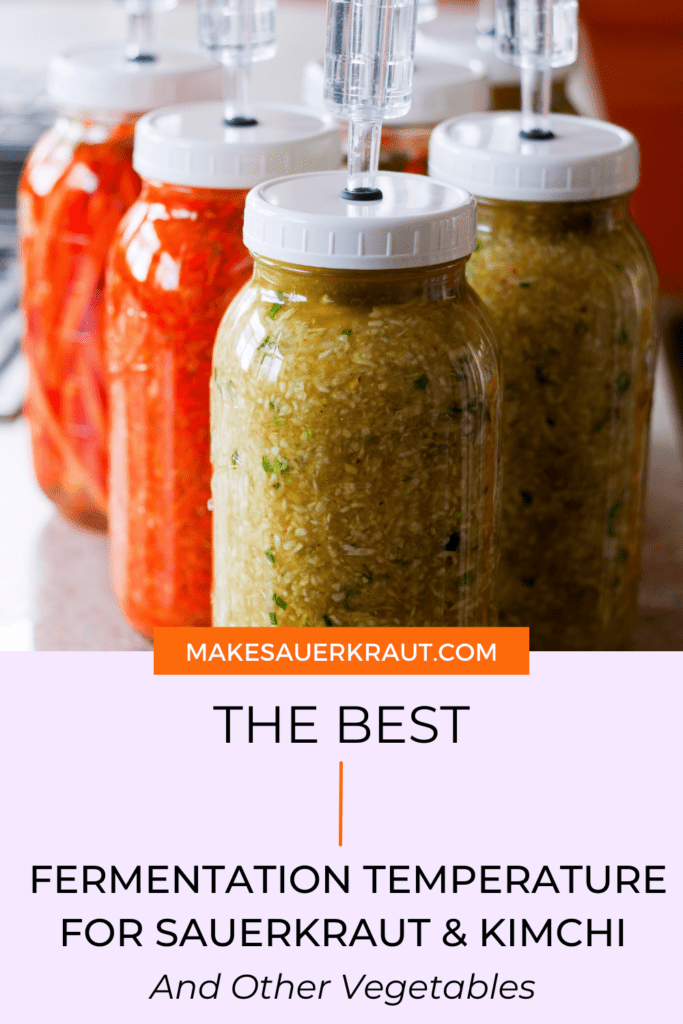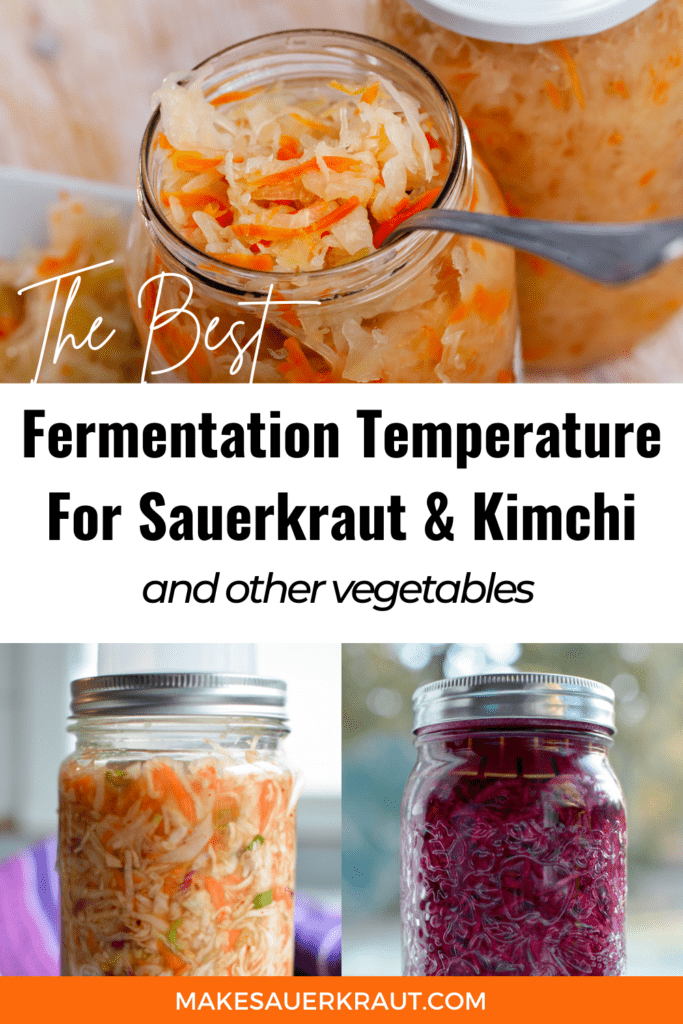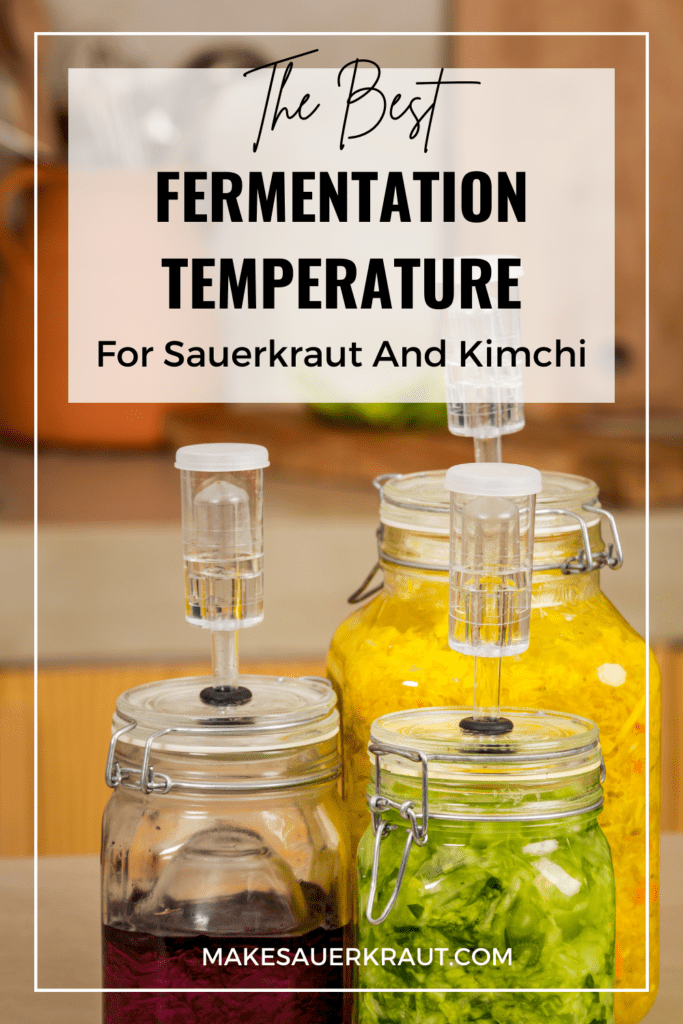Discover why the temperature you ferment at is one of the most important factors for stellar results. Learn what this ideal temperature is and why. Achieve the tang, texture, and flavor you desire for your fermented vegetables.
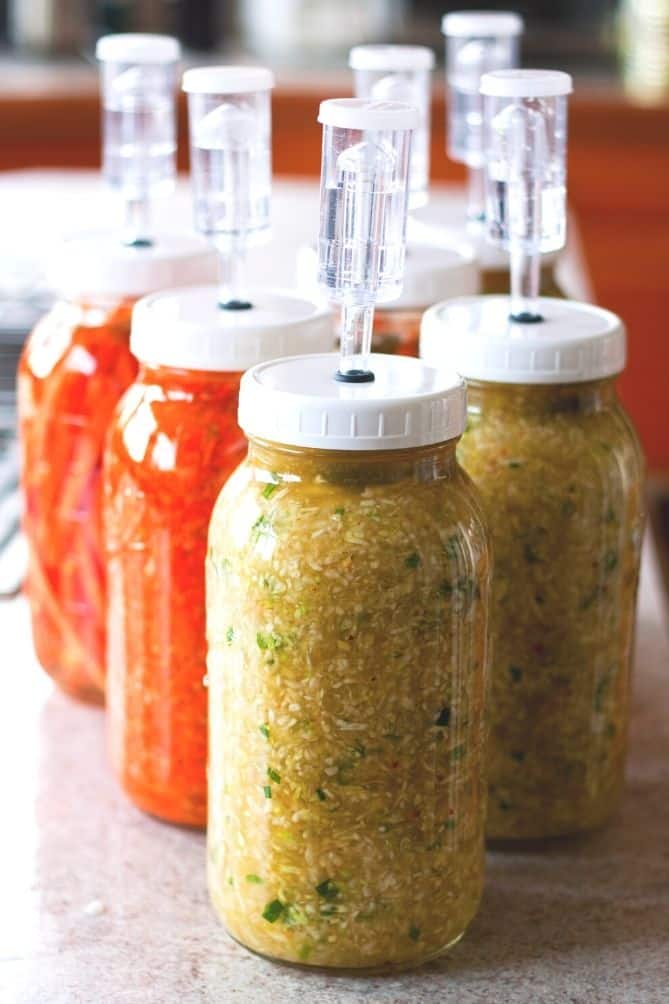
In this post, I share how fermentation temperature impacts the texture, flavor, color, and shelf life of your pickles, sauerkraut, or kimchi.
Since 2002, when I lifted the lid on my first crock of sauerkraut, I have experimented with countless batches of vegetable ferments and what factors impacted my results.
I learned that using the correct salt concentration is super important but also that the temperature of the spot where I ferment is crucial. Fermenting during hot summer days—with no AC—yielded very different results from cool fall days.
Read on to learn the best fermentation temperature range, the “sweet spot,” and how to adjust things if your fermentation space is outside this range.
First off, why does temperature matter?
Why is Fermentation Temperature Important?
We owe the beauty and flavors of tangy sauerkraut, crunchy pickles, spicy kimchi, and many other fermented foods to the bacteria that latch onto these vegetables as they are growing.
What?
Okay, so once your shredded cabbage or prepared vegetables are picked and packed into a container under some salty brine, these freeloading bacteria go to work, chomping away at the sugars in the vegetables to transform humble vegetables into flavorful, probiotic-packed superfoods.
Without bacteria, we would have no yogurt, kimchi, pickles, cheese, beer, wine, and many other foods that owe their umami-packed flavors to these tiny beings.
How well this natural interaction between these bodacious bacteria and their environment unfolds is dictated by fermentation temperature.
Nail this one and take your fermentation results to a whole new level.
Do your fermented vegetables turn out slimy, covered in yeasts or molds, or do they end up just too mushy?
Or perhaps, you see little or no bubbles forming? Maybe, you see darkness or browning of your fermenting sauerkraut or the brine of your pickled vegetables?
The temperature of the room in which you are fermenting your vegetables greatly impacts whether the finished results have a nice texture with the desired tang or are moldy, and mushy with lackluster flavors.
The Stages of Fermentation
To understand how temperate impacts fermentation, we need to first understand the stages of fermentation. Bacteria are picky about the temperature at which they like to work.
Fermentation proceeds through three different stages. In order to obtain fermented sauerkraut and vegetables of the highest quality, all those bacteria strains must ferment in a certain sequence.
Stage One: Days 1-5, approx.
At this stage, salt-tolerant bacteria produce carbon dioxide to transform your fermentation vessel into an anaerobic environment.
Fermentation starts from the moment you mix salt into your sliced cabbage and prepared vegetables.
In this first stage of fermentation, the Leuconostoc mesenteroides—the most common organisms associated with vegetables—do most of their work. They are the smallest of the three lactic acid bacteria studied and are able to tolerate salty conditions.
They break down available sugars to produce lactic acid, acetic acid (vinegar), ethyl alcohol, enzymes, and mannitol (a flavor compound that is metabolized later by Lactobacillus plantarum), all of which contribute to the characteristic flavor of high-quality sauerkraut and fermented vegetables.
The Leuconostoc mesenteroides also produce carbon dioxide (soda gas), hence the bubbles you see floating to the surface along with brine being pushed out of the jar. The carbon dioxide displaces any oxygen in the jar to help create an anaerobic fermentation environment.
Once all the oxygen is displaced, stage two begins.
If the temperature is higher than 70° F (21° C) Leuconostoc mesenteroides might not grow and that would be detrimental to the flavor and quality of your finished ferments.
Stage Two: Days 5 to 16, approx.
At this stage, bacteria, that tolerate salt and acid, create lactic acid, a preservative.
Stage two begins around day 5, after the bacteria in stage one, have died off. At this stage, the Lactobacillus plantarum does most of the work for the longest time period, from day 5 to day 16. Its only job is to eat sugar and produce lactic acid.
Lactic acid not only imparts an acidic taste but also acts as a preservative, supports digestion, inhibits the growth of harmful bacteria, and increases the bio-availability of Vitamin C, among other jobs.
If temperatures are too cool or too warm, lactic acid production will suffer.
When you ferment at too warm of temperatures, you might see a white powdery yeast growing on the surface of your ferment. This is because not enough lactic acid was produced.
Stage Three: Days 16 to 21, approx.
At this stage, beneficial bacteria create lactic acid for a greater flavor profile.
The L. pentoaceticus (L. brevis) “finish off” the sauerkraut during days 16-21 by lowering the acid levels a bit more and further dropping the pH. Once there is no more sugar, fermentation ends.
The acidic and low pH environment of stage three only allows for the growth of good lactic acid bacteria. The lactic acid development during this stage contributes greatly to the flavor profile of your batch of sauerkraut.
Any change to the above cycles of lactic acid production will alter the taste and quality of sauerkraut.
As long as the proper amount of salt is added and the recommended temperatures are observed, the three bacteria strains will ferment cabbage in the proper sequence.
What is the Best Temperature at Which to Ferment Vegetables [Chart]?
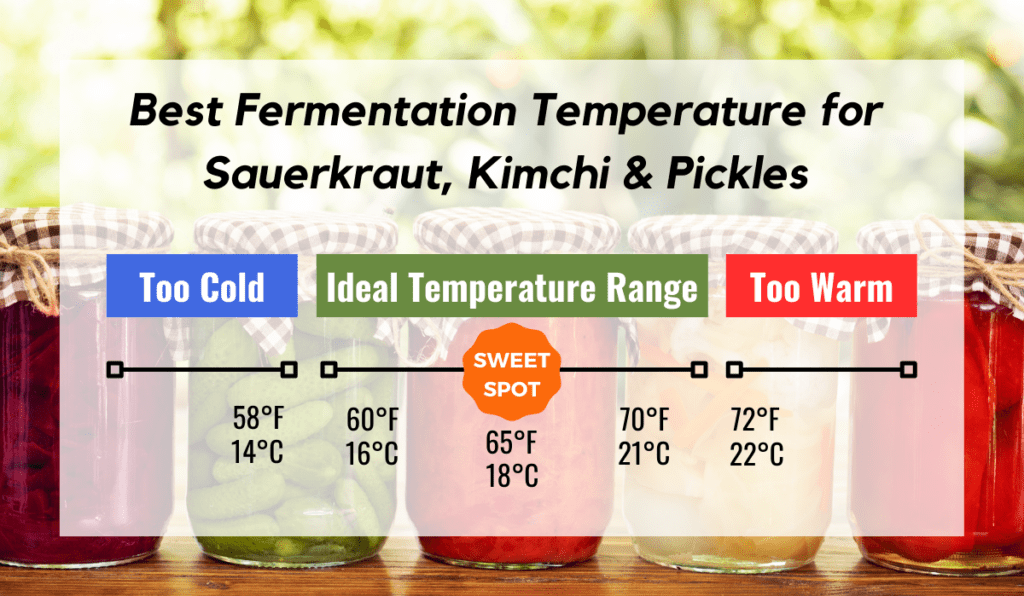
Fermentation is a complex process that relies on not only an important balance of salt and bacteria but the right temperature.
If you are wanting to produce high-quality ferments with flavors and textures that pop, you’ll want to find a spot to ferment within the ideal temperature range.
Different temperatures are ideal for different kinds of lactic acid bacteria. Temperature will:
Impact how quickly bacteria digest and ferment their available food.
Affect the rate at which bacteria produce acids.
Determine which microbial species grow and become dominant.
What byproducts and flavors are developed.
It’s all in the temperature. (And, of course, the right amount of salt.)
When fermenting within the ideal temperature range, the correct bacteria survive and flourish and the levels of lactic acid they create are ideal.
Ideal Temperature Range: 60° F (16° C) to 70° F (21° C)
Fermentation at 60° F (16° C) to 70° F (21° C) is ideal with the sweet spot being 65° F (18° C). This temperature range is slow enough to support the growth of Lactobacillus bacteria and Leuconostoc mesenteroides to allow for the development of complex flavors and retain texture.
In addition, ferments made at these temperatures seem to last longer in cold storage without browning or growing yeasts and molds.
If your ferments mold during storage, the culprit is often that all the fermentation stages did not properly unfold due to too high or too low of fermentation temperatures.
Too Warm: 72° F (22° C)
Fermentation at 72° F (22° C), or higher, is too warm. Though these temperatures result in a rapid formation of acid, you often end up with mushy, soft, and even pink sauerkraut.
This is because the pectin-eating lactic acid bacteria are more active at these higher temperatures, breaking vegetables down into softer textures.
The finished flavor is sharp and funky, rather than tangy. And, when moved to cold storage, the ferments may not last as long and are more prone to yeast spoilage.
Additionally, these high temperatures favor the growth of Streptococcus faecalis and Pediococcus cerevisiae. These bacteria produce only lactic acid and do not produce the CO2 necessary to create an anaerobic condition.
For this reason, a temperature must be selected which gives a rapid fermentation without sacrificing the quality of the product.
Too Cold: 58° F (14° C)
Fermentation at 58° F (14° C), or lower, is too cool and progresses very slowly. The bacteria digest the vegetables more slowly. Acids are not produced quickly enough giving harmful bacteria and mold the opportunity to take over.
The Research Behind the Best Fermentation Temperature
We owe much of our recent understanding of the impact of temperature on fermentation to a pretty cool 2017 study, the Effect of Temperature on Fermentation and Quality of Sauerkraut.
Effect of Temperature on Fermentation and Quality of Sauerkraut.
In their study, separate batches of sauerkraut were fermented at three different temperatures with each temperature treatment replicated seven times:
Low Temperature: 59-68° F (15-20° C)
Ambient Temperature: 77-86° F (25-30° C)
High Temperature: 95-104F (35-40° C)
The sauerkraut was fermented for 28 days with readings taken every 7 days for pH, Brix, acidity, lactic acid, ascorbic acid, color, texture, and flavor.
pH. The measure of acidity present in food. The more acidic the food, the more resistant it is to microbial growth. Fermented foods are safe to consume at a pH of 4.6 or lower.
Brix. The measure of the natural sugar content in foods. The variety of cabbage and the growing conditions and soil health will impact the initial Brix reading of cabbage.
Since bacteria consume sugars in the ferment to make lactic acid, Brix readings will impact lactic acid numbers.
Organic EDEN Sauerkraut is made from the finest cabbage grown in nutrient-rich organic soil, carefully tended, harvested, and fermented by USA family farmers. They tend hundreds of acres of vital soil enriched by years of sophisticated, on-farm composting operations. They take tree leaves, their own organic production by-products, and skillfully make rich organic compost. Soil thus enriched retains moisture, does not require irrigation and produces sturdy high Brix plants.
—Eden Foods
Lactic Acid. Formed during the fermentation process by the lactic acid bacteria. Acts as a preservative and gives fermented foods that familiar tang.
Ascorbic Acid. The vitamin C content.
A taste panel of 10 persons, trained by a professional specialist in sensory evaluation, rated the color, texture, and flavor of the various batches of fermented sauerkraut.
Study results revealed that low temperatures (59-68° F, 15-20° C) were most effective for obtaining the ideal acidity and lactic acid numbers while maintaining low pH, high Brix and ascorbic acid, and superior sensory quality, especially with respect to texture.
Temperatures above 70° F (21° C0) do not support the growth of Leuconostoc mesentoroides, the bacteria necessary for sauerkraut with good flavor and quality.
Further, warmer temperatures favor the growth of Streptococcus faecalis and Pediococcus cerevisiae. Not good. These bacteria produce only lactic acid and do not produce the CO2 necessary to create an anaerobic condition.
Fermentation Temperature Impact On Kimchi
In addition, Anne Wolfe over at Cook’s Science carried out a detailed experiment on how temperature impacts the flavor and texture of various batches of kimchi.
Different temperatures are ideal for different kinds of bacteria, which become the dominant microbe at work when the ferment reaches its ideal temperature. Each microbial community develops different by-products, and therefore different flavors.
So, by controlling the temperature and therefore the environment in which my kimchi was fermenting, I could essentially control which bacteria survived and flourished.
—Anne Wolfe, Understanding Kimchi: The Science of Fermenting Cabbage
She made three batches of kimchi at temperatures similar to the study above and verified taste results with lab tests that analyzed bacterial compositions in the various batches.
I found that the ideal environment for lactic acid–producing bacteria to thrive and create the perfect balance of “funky” flavors is somewhere between 50 and 70 degrees. The ultimate sweet spot, 65 degrees, provides the optimal environment for kimchi with a thickened, tangy brine, a balance of mellow fishy and cheesy notes, a touch of fizz, crunchy cabbage, and well-rounded flavor.
—Anne Wolfe, Understanding Kimchi: The Science of Fermenting Cabbage
Now, how does one go about setting up a fermentation station with these ideal temperatures?
Controlling Fermentation Temperature
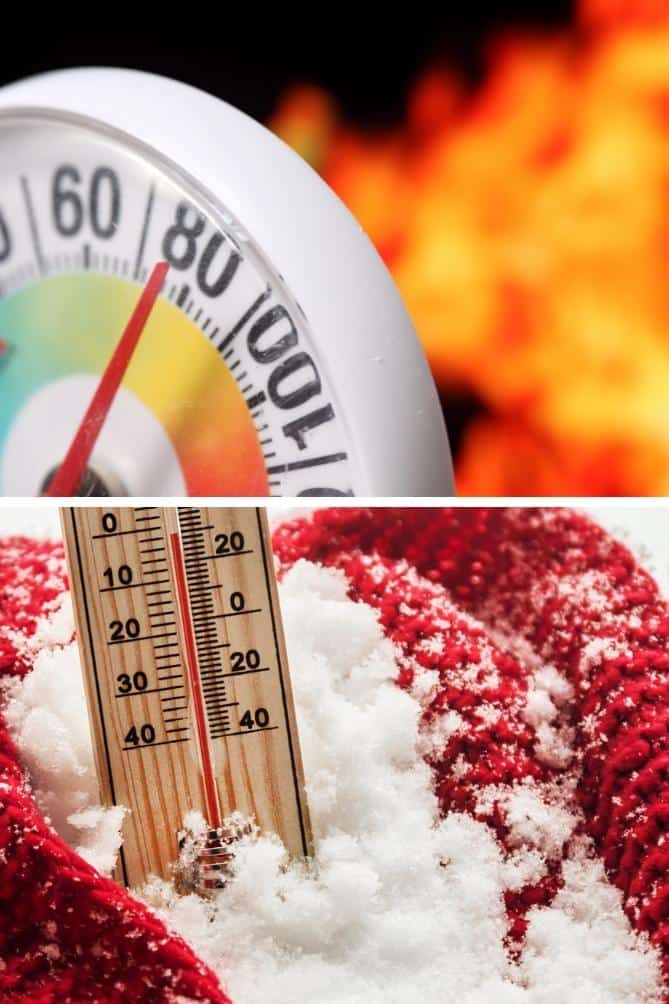
Now that you know the ideal temperature for fermentation, how do you go about monitoring and controlling the temperature?
First off, invest in a thermometer and place it on the counter right next to your ferment(s).
My favorite thermometer is made by ThermoPro.
This thermometer displays both the current temperature along with the high and low temperatures for the time period you’re using it. A button on the back can be used to reset everything back to zero.
The ThermoPro can toggle between temperatures in Fahrenheit or Celsius. It also tracks humidity.
You may need to vary your fermentation spot throughout the year. The perfect spot in winter may be too hot during the summer.
Too Warm for Fermentation?
If your home is too warm, you may need to either find a cooler spot in your home or place your jars in an ice chest with frozen jugs of water that you regularly replace.
Always keep your ferments out of direct sunlight and away from places that retain lots of heat.
If temperatures widely fluctuate, like when using a wood stove, look for a location in your home least impacted by the heat from your wood stove. For me, our hallway is the farthest from both of our wood stoves where I find temperatures to be stable.
See also 11 Cool Fermentation Tips for Hot Weather.
Too Cool for Fermentation?
If your home is too cool, either try to find a warmer spot in your home—the top of your fridge, perhaps—or invest in a seedling mat with a temperature controller. Place a bath towel on top of the mat, and then your jars.
Here is one by Vivosun.
Many invest in a dorm or wine fridge and use that as their fermentation chamber. Check before purchasing that it can be set to 65° F (18° C), the ultimate sweet spot.
When you head off to make your next batch of fermented sauerkraut, kimchi, or pickles, take time to find a spot within the ideal temperature range. The hard-working bacteria will thank you.
Frequently Asked Questions
No. The average fridge temperature is too cool for the bacteria responsible for fermentation to be active.
Yes. The greatest quality sauerkraut is made at temperatures ranging from 60° F (16° C) to 70° F (21° C), with no temperature swings more than 5° F (3° C). If your home is significantly warmer than this, experiment with fermenting for a shorter amount of time.
Yes, it is certainly possible to ferment sauerkraut for too long. you’ll know this has happened if your sauerkraut is mushy.
Ideally, the cabbage should retain a crunch to it. I like to check it every 7 days or so, just to avoid going too long. You’ll find a sweet spot where it is just right for your tastes.
Some people prefer crunchy and less tangy, and ferment for less time. Others prefer the tang and a slightly softer product and ferment for a longer time period.
The ideal temperature for fermenting sauerkraut is between 60° F (16° C) to 70° F (21° C). Aim for 65° F (18° C) with a temperature fluctuation of no more than 5 degrees in either direction to ensure a nice even fermentation. At lower temperatures, the fermentation process becomes slower, and the sauerkraut retains more or a crunch. It also allows the cabbage to develop great flavor.
Let us know in the Comments what temperature you ferment at or your trick for controlling temperature.
Last update on 2024-04-25 / Affiliate links / Images from Amazon Product Advertising API

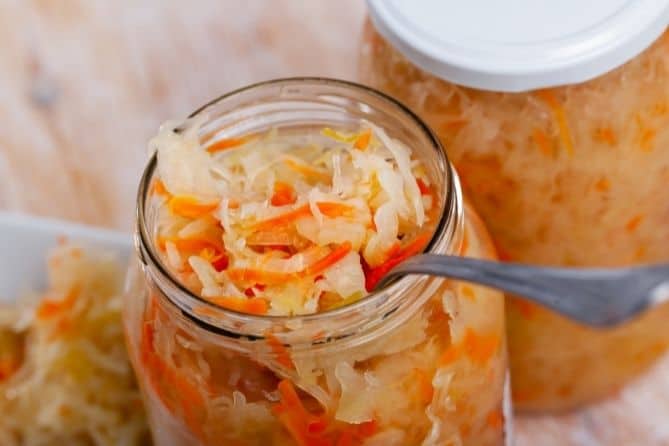

 This post may contain affiliate links which won’t change your price but will share some commission.
This post may contain affiliate links which won’t change your price but will share some commission.